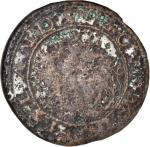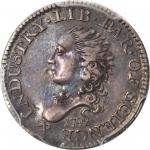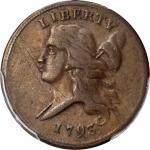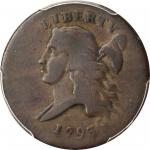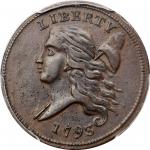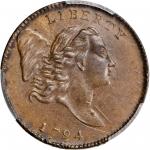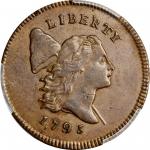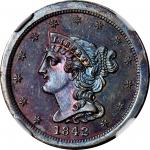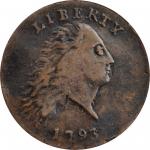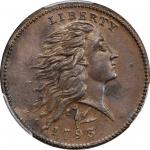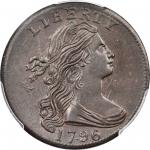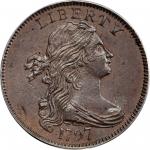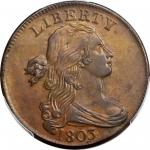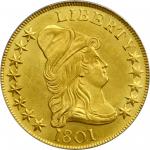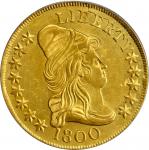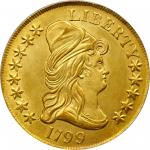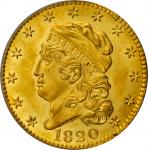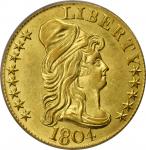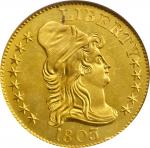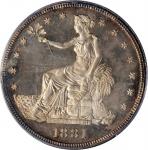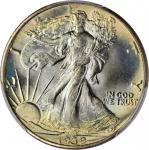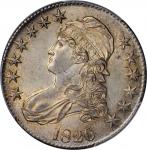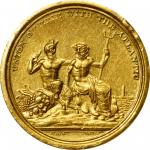1826 Erie Canal Completion. Gold. 45 mm. 43.67 grams. HK-1001. Rarity-9. EF-45 (NGC). Here is a lovely example of this rare, historic and eagerly sought early American medal. Even medium gold surfaces retain ample evidence of a satin to modestly semi-prooflike finish. There is modest reflectivity in the protected areas around some of the design elements. The detail is universally sharp throughout the obverse, and bold on the reverse apart from a touch of softness to the high points. Wispy marks on both sides are the result of light handling appropriate for the grade. The most significant for provenance purposes are a few minor edge bumps at 2 oclock on the obverse and 9 oclock on the reverse. Highly attractive for the assigned grade, and sure to attract spirited bidding from advanced specialists.When completed on October 26, 1825, the Erie Canal was an engineering marvel nearly four decades in the making, having first been proposed in the 1780s. The canal connected Buffalo and the Great Lakes in the west to Albany and the Hudson River in the east, and by extension to New York City and the Atlantic Ocean via the Hudson River. Its completion ushered in an era of economic, cultural and political prosperity in New York and specifically New York City, whose increasing importance as a port city outpaced competing ports along the eastern seaboard. The Canal brought the agricultural products of the western interior to markets in the East, and transported finished goods from the port of New York City to the interior, all the while slashing the cost of transportation by 95% from overland routes.Governor DeWitt Clinton led a nine-day procession from Buffalo to New York City on board the <em>Seneca Chief </em>to celebrate the opening of the Canal. The trip commenced in Buffalo on October 26, 1825, and ended in New York Harbor on November 4, at which time Governor Clinton poured water from Lake Erie into the harbor in a ceremony dubbed the "Wedding of the Waters."To commemorate the Canals completion, which was the largest and most advanced construction project of its era anywhere in the world, the Common Council of New York City authorized a medal and put its execution in the able hands of Archibald Robertson, a contemporary American artist. Detailed information about the medals is found in Robertsons report in the 1826 publication of <em>An Account of the Grand Canal Celebration at New York November the Fourth 1825</em>, which itself is an appendix to Cadwallader Coldens 1825 <em>Memoir</em> detailing the evolution of the Erie Canal. We learn that Robertson himself designed the medal, that iron and steel worker William Williams made the dies upon which famed medalist Charles Cushing Wright engraved the designs and Richard Trested punched the legends. The medals were struck by Maltby Pelletreau of Pelletreau, Bennett and Cooke, Pelletreau being from a family of New York silversmiths dating back to colonial times.Robertson writes that "The first of my operations was to make an appropriate Device, intended for a Medal, to be worn by the guests of the Corporation [of the City of New York] on the joyful day; but time not permitting the execution of such a work as would be worthy of the occasion, it was resolved to have the Device engraved by a first-rate artist, and postpone the Medal to be executed at leisure..." A satin badge was created in lieu of the medals, using Robertsons design for the "device," a version of which appears on the medals that were eventually struck. Robertson does not elucidate when the medals were actually made, which had to be sometime between the grand November 4, 1825, New York City celebration at the end of Governor Clintons procession (Robertsons "joyful day") and the eyewitness account of a medal published in the April 25, 1826 edition of the <em>American Traveller</em> newspaper, which was referenced in the August 10, 2003 issue of the <em>E-Sylum</em>:<em>"Canal Medals.--We have seen one of the Medals struck in honor of the Canal celebration by order of the Corporation of New-York. On one side is Pans visit to Neptune-with cornucopia, distant view of the ocean, light house, &c. with the inscription--"Union of Erie with the Atlantic." On the reverse, are the arms of the state; on the right the representation of the canal, with its locks, and on the left the city of New York. The medal was designed by Archibald Robertson, engraved by C.C. Wright, and struck by Pelletreu. The whole is neat and appropriate. The medals struck on composition [white metal] will be presented to all the invited guests of the corporation; silver ones will be transmitted to the President, Heads of Departments, Foreign ministers, Governors of States, &c. It is with great pleasure we learn that three gold medals will be transmitted to the surviving signers of the Declaration of Independence."</em>The white metal impressions have been assigned the attribution HK-1 in the standard reference <em>So-Called Dollars</em> by Harold E. Hibler and Charles V. Kappen, the low attribution number signifying that the Erie Canal Completion medal is the oldest in the so-called dollar series, which includes more than 1,000 types. The silver and gold impressions, however, are cataloged as HK-1000 and HK-1001, respectively, the higher numbers assigned by the Hibler-Kappen reference indicating that these pieces are considered uncollectible.Other than the specific reference to three gold medals being presented to surviving signers of the Declaration of Independence (see below), the account in the <em>American Traveler</em> does not specifically state how many examples were struck in any composition. In fact, the exact number of specimens produced has been the subject of debate among numismatic researchers.The 2008 edition of the Hibler-Kappen reference states:<em>"Fifty-one Gold medals struck; presented to crowned heads of world and eminent men including General Lafayette and 3 surviving signers of [the] Declaration of Independence. Several hundred pieces struck in Silver and White Metal (pewter); presented to guests and officials."</em>The source for the Hibler-Kappen mintage figures is unknown and, in the specific case of the gold impressions, a production run of 51 medals seems high when viewed in light of the number of specimens actually distributed in 1826, for which we have contemporary documentation. The following extract from the formal resolution regarding the termination of the Grand Canal Celebration in New York City in early 1826 was published later that year (November 26) in the <em>Buffalo Journal</em>:<em>"RESOLVED UNANIMOUSLY, - That Medals, Boxes, and Copies of Mr. Coldens Memoir, be reserved to be hereafter distributed under the special direction of the Common Council.</em><em>"CLASS III.</em><em>"To the family of George Washington as a tribute of profound respect for the memory of him who "first in war, first in peace, and first in the hearts of his fellow-citizens," covered the American name with imperishable glory, a Medal of gold of the highest Class, a Box made of maple, brought from Lake Erie in the first Canal-boat the Seneca Chief, and a copy of the Memoir of Mr. Colden; the same to be presented on behalf of the Corporation of the City of New York, and in the name of the City.</em><em>"The same to the three surviving Signers of the Declaration of Independence, as a tribute of profound respect for those memorable patriots who, in its support, pledged "their lives, their fortunes, and their sacred honor." - JOHN ADAMS, of Quincy, Massachusetts; CHARLES CARROLL, of Carrollton, Maryland; THOMAS JEFFERSON, of Monticello, Virginia.</em><em>"The same to the last surviving Major General of the Army of the Revolution, as a tribute of profound respect, for those officers and soldiers whose valour and patriotism, secured to us the blessings we now enjoy - Major-General La Fayette.</em><em>"The same to the Senior Officer, now living, of the Navy of the Revolution, as a tribute of profound respect for that infant power which promises to be the future bulwark of the Republic.</em><em>"The same to the President and Ex-Presidents of the United States, as a tribute of profound respect to those citizens, who by eminent public services have attained the highest office in the gift of the Republic.</em><em>"JOHN QUINCY ADAMS, President.</em><em>"Ex-Presidents of the United States now living.</em><em>"JOHN ADAMS, THOMAS JEFFERSON, JAMES MADISON, JAMES MONROE</em><em>"The same to the family of Robert Fulton, as a tribute of profound respect for the memory of him, who by applying the power of steam to the purposes of navigation, justly ranks amongst the greatest benefactors of his native country, and of the world.</em><em>"The same to the author of the Memoir, CADWALLADER D. COLDEN."</em>This resolution clearly states that 11 gold medals were <em>distributed</em> to dignitaries, including the three surviving signers of the Declaration of Independence noted in the April 25, 1826, edition of the <em>American Traveller</em>. (John Adams and Thomas Jefferson each received only one medal, even though they are referenced twice in the resolution as former presidents as well as signers of the Declaration.) On the other hand, the resolution does not state how many gold medals were actually struck. Given that one example was presented to Andrew Jackson in 1828 (see below) -- who was not mentioned as a recipient in the 1826 resolution -- it is possible that more than 11 gold impressions were produced. With only three specimens extant as of this writing, the mintage figure of 51 pieces in the Hibler-Kappen reference is probably overly generous. Yet even if the original distribution was only about 11 or 12 examples, we find it curious that only three specimens have survived. These were, after all, gold medals produced to commemorate a significant event in early American history that went to a highly select group of individuals, American presidents, signers of the Declaration of Independence and Revolutionary War heroes among them. One would think that most specimens would have survived, either still owned by the descendants of the original recipients or dispersed into private collections or museums.Regardless, only three gold impressions of the Erie Canal Completion medal are positively confirmed to exist, making this not only the rarest metallic composition of the type, but also one of the rarest early American medals. Of the three specimens known, only two are in private hands:1 - NGC Proof-62. Ex President John Quincy Adams; John Adams II; Mary Louisa Adams (one of John Adams IIs daughters); further descendants of John Quincy Adams, including a great-great granddaughter of Mary Louisa who consigned it to the following; Skinner, Inc.s sale of October 2012, lot 185; Heritages FUN Signature Auction of January 2014, lot 5642. This is one of the 11 gold medals referenced in the resolution regarding the termination of the Grand Canal Celebration in New York City in early 1826, which makes clear that it was presented to John Quincy Adams during his presidency.2 - NGC EF-45. Ex Heritages Long Beach, CA Tokens & Medals Signature Auction of September 2007, lot 81492. <em>The present example</em>.3 - "Extremely Fine." Ex Andrew Jackson; unknown intermediaries; Anderson Galleries sale of the W.W.C. Wilson Collection (cataloged by Wayte Raymond), 1925, lot 823; New York Historical Society, donated 1832. In his cataloging for this medal when offered in 1925, Wayte Raymond states:<em>"Presented to Gen. Andrew Jackson, Jan. 15, 1828 at a reception and dinner given in his honor by the citizens of New Orleans. J. H. Hamilton, Samuel Allen, and Thaddeus Phelps were present as delegates from New York to help elect Jackson president. Mr. Hamilton presented the medal, In the name of the Corporation of the City of New York. For a full account see </em>Virginia Advocate<em> Feb. 9, 1828."</em>Jackson won his bid for the presidency in the 1828 election, eventually serving two terms as our nations seventh president from March 4, 1829, to March 4, 1837. As Jackson was not among the original recipients of a gold Erie Canal Completion medal as outlined in the 1826 resolution, his medal appears to be a 12th specimen not mentioned therein.This is a historic and exceedingly rare medal commemorating one of the most important engineering achievements of the early United States. Interested collectors are urged to enter strong bids, and prepare for strong competition, as once this rarity sells it may be many years, if not decades, before a gold Erie Canal Completion medal makes another appearance at auction. From the Richard Jewell Collection. Earlier ex Heritages Long Beach, CA Tokens & Medals Signature Auction of September 2007, lot 81492.

